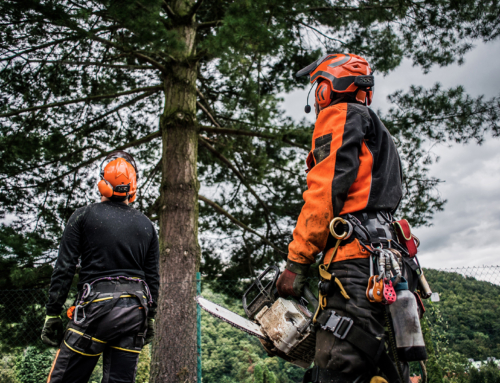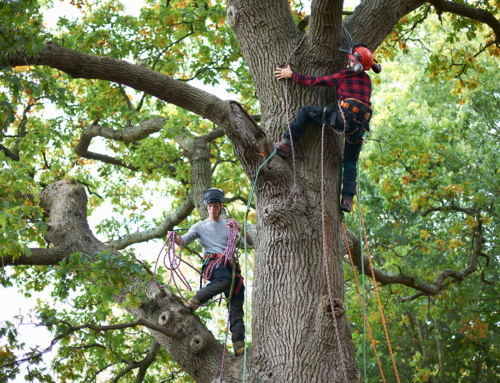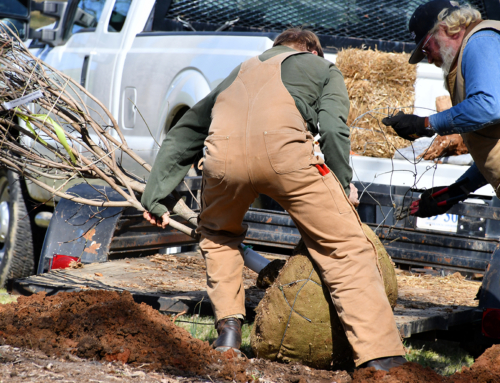Understanding Arborist Cabling and Bracing
When it comes to maintaining the health and stability of your trees, there’s no one better to trust than Skyline Arborist. With their expert cabling and bracing services, they ensure that your trees stay strong and secure, even in the harshest weather conditions. Skyline Arborist’s team of highly trained professionals use state-of-the-art techniques and equipment to provide effective and safe cabling and bracing solutions. Their methods not only support weak or damaged branches but also help prevent potential hazards by reducing the risk of branch failure.
Arborist cabling and bracing are specialized techniques used to provide additional support and stability to trees. Cabling involves the installation of strong, flexible cables between the main branches or between the trunk and branches of a tree. This helps to distribute the weight of the tree more evenly, reducing the strain on individual branches and preventing them from breaking. Bracing, on the other hand, involves the installation of rigid rods or bars between the trunk and branches or between different branches. This helps to stabilize the tree and prevent excessive movement, especially in high winds or during storms.
Both cabling and bracing are essential for the long-term health and safety of your trees. They help to maintain the structural integrity of the tree, prevent the formation of cracks or splits, and reduce the risk of limb or branch failure. By incorporating these techniques into your tree maintenance routine, you can ensure that your trees remain strong, resilient, and able to withstand the challenges of the natural environment.
When is Arborist Cabling and Bracing Necessary?
Arborist cabling and bracing services are necessary in a variety of situations, each with its own unique set of requirements and considerations. One of the most common reasons for cabling and bracing is to address structural weaknesses or imbalances within a tree. This can occur due to a variety of factors, such as the natural growth patterns of the tree, damage from storms or other weather events, or even the presence of disease or pests.
For example, if a tree has a narrow, upright growth habit or a significant lean, it may be prone to instability and the risk of falling or breaking. In these cases, cabling and bracing can help to redistribute the weight of the tree and provide the necessary support to keep it standing upright and secure. Similarly, if a tree has suffered damage to its trunk or branches, cabling and bracing can help to stabilize the affected areas and prevent further deterioration.
Another common reason for arborist cabling and bracing is to prevent the failure of large, heavily-laden branches. As trees mature, their branches can become increasingly heavy and prone to breaking, especially during high winds or heavy snowfall. By installing cables or braces, arborists can help to distribute the weight of these branches more evenly, reducing the strain on the tree and decreasing the risk of catastrophic branch failure.
Regardless of the specific situation, the decision to utilize arborist cabling and bracing services should be based on a thorough assessment of the tree’s condition and the potential risks it poses. A professional arborist can evaluate the tree, identify any areas of concern, and recommend the most appropriate cabling or bracing solution to ensure the long-term health and stability of the tree.
Benefits of Arborist Cabling and Bracing
The benefits of arborist cabling and bracing services are numerous and far-reaching, making them an essential component of any comprehensive tree maintenance program. One of the primary benefits is the enhanced structural integrity and stability of the tree, which can help to prevent the formation of cracks, splits, or other types of damage that can compromise the tree’s overall health and longevity.
By distributing the weight of the tree more evenly and providing additional support to weak or vulnerable areas, cabling and bracing can help to reduce the risk of branch or limb failure, even in the face of severe weather conditions or other external stressors. This not only protects the tree itself but also helps to safeguard nearby structures, vehicles, and pedestrians from the potential hazards of falling branches or trees.
Another key benefit of arborist cabling and bracing is the improved aesthetic appearance of the tree. By addressing structural issues and maintaining the tree’s overall shape and form, these services can help to enhance the visual appeal of the tree and its surrounding landscape. This can be particularly important for trees that are located in high-visibility areas, such as public parks, commercial properties, or residential neighborhoods, where the appearance of the trees is an important consideration.
In addition to these tangible benefits, arborist cabling and bracing services can also contribute to the long-term health and vitality of the tree. By providing the necessary support and stability, these techniques can help to reduce the stress and strain on the tree, allowing it to focus its energy on growth, repair, and other essential life processes. This, in turn, can help to extend the tree’s lifespan and ensure that it continues to thrive and contribute to the overall ecosystem for years to come.
The Process of Arborist Cabling and Bracing
The process of arborist cabling and bracing involves a series of carefully planned and executed steps, each designed to ensure the safety, effectiveness, and longevity of the installed systems. The first step in this process is a thorough assessment of the tree, conducted by a trained and experienced arborist. During this assessment, the arborist will evaluate the tree’s overall condition, identify any areas of concern or weakness, and determine the most appropriate cabling or bracing solution.
Once the assessment is complete, the arborist will develop a customized plan for the installation of the cabling or bracing system. This plan will take into account factors such as the size and structure of the tree, the location and orientation of the branches or limbs that require support, and any potential obstacles or hazards that may need to be addressed during the installation process.
With the plan in place, the arborist’s team will begin the installation process, using specialized equipment and techniques to ensure the safe and efficient placement of the cabling or bracing components. This may involve the use of climbing harnesses, aerial lifts, or other specialized tools to access the upper reaches of the tree, as well as the careful drilling and installation of attachment points, such as lag bolts or eye bolts, to secure the system in place.
Throughout the installation process, the arborist and their team will take great care to minimize any damage or disruption to the tree, ensuring that the cabling or bracing system is integrated seamlessly and without causing undue stress or harm. Once the installation is complete, the arborist will conduct a final inspection to ensure that the system is properly secured and functioning as intended.
Types of Materials Used in Arborist Cabling and Bracing
Arborist cabling and bracing services utilize a variety of specialized materials and equipment to ensure the safety, effectiveness, and longevity of the installed systems. One of the most important components of these systems is the cabling or bracing material itself, which must be carefully selected to meet the specific needs and requirements of the tree.
For cabling, arborists commonly use high-strength, flexible cables made from materials such as galvanized steel, stainless steel, or synthetic fibers like polyester or nylon. These cables are designed to withstand the weight and tension of the tree’s branches, as well as the forces of wind, rain, and other environmental factors. The cables are typically equipped with specialized attachments, such as lag bolts or eye bolts, that allow them to be securely anchored to the tree’s trunk or branches.
In the case of bracing, arborists may use a range of materials, including rigid metal rods or bars, as well as specialized bracing systems that incorporate both rigid and flexible components. These materials are chosen based on the specific needs of the tree, the location and orientation of the branches or limbs that require support, and the overall structural integrity of the tree.
In addition to the cabling and bracing materials themselves, arborists also utilize a variety of specialized tools and equipment to ensure the safe and effective installation of these systems. This may include climbing harnesses, aerial lifts, power drills, and other specialized equipment that allows them to access and work on the tree in a safe and efficient manner.
Hiring a Professional Arborist for Cabling and Bracing Services
When it comes to arborist cabling and bracing services, it’s essential to work with a qualified and experienced professional. Skyline Arborist is a trusted leader in the industry, with a team of highly trained and certified arborists who are dedicated to providing the best possible care for your trees.
One of the key advantages of working with Skyline Arborist is their commitment to using the latest techniques and equipment in their cabling and bracing services. They stay up-to-date with industry best practices and are constantly exploring new and innovative ways to support the health and stability of trees. This ensures that their clients receive the most effective and reliable solutions for their specific needs.
In addition to their technical expertise, the team at Skyline Arborist is also known for their exceptional customer service. They take the time to understand the unique needs and concerns of each client, and they work closely with them to develop a customized plan that addresses their specific requirements. Whether you’re a homeowner, a business owner, or a property manager, Skyline Arborist is dedicated to providing you with the personalized attention and support you need to keep your trees healthy and thriving.
When you choose Skyline Arborist for your arborist cabling and bracing needs, you can rest assured that your trees are in the hands of true professionals. From the initial assessment to the final installation, you can trust that Skyline Arborist will deliver the highest quality of service and the best possible outcomes for your trees.
Common Misconceptions About Arborist Cabling and Bracing
Despite the many benefits of arborist cabling and bracing services, there are still some common misconceptions and myths that can deter people from seeking out these important tree care solutions. One of the most prevalent myths is that cabling and bracing are only necessary for older or damaged trees. In reality, these services can be beneficial for trees of all ages and conditions, as they help to maintain the overall structural integrity and stability of the tree, regardless of its age or current state.
Another common misconception is that cabling and bracing are temporary fixes that will ultimately weaken or damage the tree. In fact, when installed properly by a trained arborist, these systems are designed to provide long-term support and stability without causing any harm to the tree. In many cases, the use of cabling and bracing can actually extend the lifespan of a tree by preventing the formation of cracks, splits, or other structural issues that can lead to decline or failure.
Some people also believe that cabling and bracing are expensive and unnecessary, especially for smaller or less valuable trees. However, the cost of these services is often far outweighed by the benefits they provide, both in terms of the tree’s health and the safety of the surrounding environment. Investing in arborist cabling and bracing can help to prevent costly and potentially dangerous tree failures, making it a wise and cost-effective investment in the long run.
By addressing these common misconceptions and educating the public about the true value and importance of arborist cabling and bracing services, Skyline Arborist aims to empower their clients to make informed decisions about the care and maintenance of their trees. With a commitment to transparency and a deep understanding of the science behind these techniques, Skyline Arborist is dedicated to helping their clients achieve the best possible outcomes for their trees.
FAQs About Arborist Cabling and Bracing
Q: How do I know if my tree needs cabling or bracing? A: The best way to determine if your tree needs cabling or bracing is to have a professional arborist inspect it. They will assess the tree’s overall condition, identify any areas of concern, and recommend the most appropriate solution.
Q: How long do arborist cabling and bracing systems last? A: Properly installed cabling and bracing systems can last for many years, typically 10-15 years or more, depending on the materials used and the ongoing maintenance of the system.
Q: Does cabling or bracing damage the tree? A: No, when installed correctly by a trained arborist, cabling and bracing systems are designed to provide support without causing any harm to the tree. In fact, they can actually help to prevent damage and extend the tree’s lifespan.
Q: How often do I need to have my tree’s cabling or bracing system inspected? A: It’s generally recommended to have your tree’s cabling or bracing system inspected annually by a professional arborist. This ensures that the system is still functioning properly and that any necessary adjustments or repairs can be made.
Q: Can I install cabling or bracing on my own? A: While it’s possible for a homeowner to install basic cabling or bracing systems, it’s generally recommended to work with a professional arborist. Arborists have the specialized knowledge, equipment, and training to ensure the safe and effective installation of these systems.
Q: How much does arborist cabling and bracing cost? A: The cost of arborist cabling and bracing services can vary depending on factors such as the size and complexity of the tree, the materials used, and the location of the job. On average, the cost can range from $500 to $2,000 or more per tree.
By providing clear and concise answers to these common questions, Skyline Arborist demonstrates their commitment to educating their clients and empowering them to make informed decisions about the care and maintenance of their trees.
Cost of Arborist Cabling and Bracing Services
The cost of arborist cabling and bracing services can vary widely depending on a number of factors, including the size and complexity of the tree, the materials used, and the location of the job. Generally speaking, the cost can range anywhere from $500 to $2,000 or more per tree.
One of the primary factors that can impact the cost of arborist cabling and bracing is the size and structure of the tree. Larger, more mature trees with extensive branching systems or multiple points of weakness may require more extensive cabling or bracing solutions, which can increase the overall cost of the project. Similarly, trees with complex or irregular growth patterns may require more specialized techniques and equipment, further adding to the overall cost.
The materials used in the cabling and bracing systems can also play a significant role in the final cost. High-quality, durable materials like galvanized steel or stainless steel tend to be more expensive than synthetic or lower-grade options, but they also offer greater long-term durability and reliability. Arborists may also need to use specialized tools or equipment, such as aerial lifts or climbing gear, which can add to the overall cost of the project.
Finally, the location of the job can also be a factor in the cost of arborist cabling and bracing services. Jobs in urban or densely populated areas may require additional safety precautions or the use of specialized equipment, which can drive up the overall cost. Similarly, jobs in remote or hard-to-access areas may require additional travel time or logistical considerations, further increasing the cost.
Despite the potential for variability in cost, the benefits of arborist cabling and bracing services far outweigh the initial investment. By protecting the structural integrity and long-term health of your trees, these services can help to prevent costly and potentially dangerous tree failures, making them a wise and cost-effective investment in the long run.
Conclusion: The Importance of Professional Arborist Cabling and Bracing Services
In conclusion, the importance of professional arborist cabling and bracing services cannot be overstated. These specialized techniques are essential for maintaining the health, stability, and longevity of trees, providing critical support and protection against the various challenges that trees may face throughout their lifespans.
By working with a trusted and experienced arborist like Skyline Arborist, homeowners, business owners, and property managers can ensure that their trees receive the highest level of care and attention. Skyline Arborist’s team of certified professionals use state-of-the-art equipment and techniques to assess the specific needs of each tree and develop customized cabling and bracing solutions that address those needs effectively and efficiently.
Whether you’re dealing with a tree that has suffered damage from a storm, a tree with structural weaknesses, or a tree that simply needs additional support to maintain its shape and form, Skyline Arborist has the expertise and the resources to provide the solutions you need. By investing in their cabling and bracing services, you can rest assured that your trees will remain strong, secure, and able to withstand the challenges of the natural environment for many years to come.
So, if you’re looking to protect the health and stability of your trees, don’t hesitate to reach out to Skyline Arborist. With their commitment to excellence, their passion for tree care, and their unwavering dedication to their clients, they are the trusted partner you need to keep your trees healthy, safe, and beautiful for generations to come.
Skyline Tree Service is a locally owned and operated tree service company based out of the greater Mammoth Lakes, June Lake, and Bishop CA area. Please contact us for an appointment.


